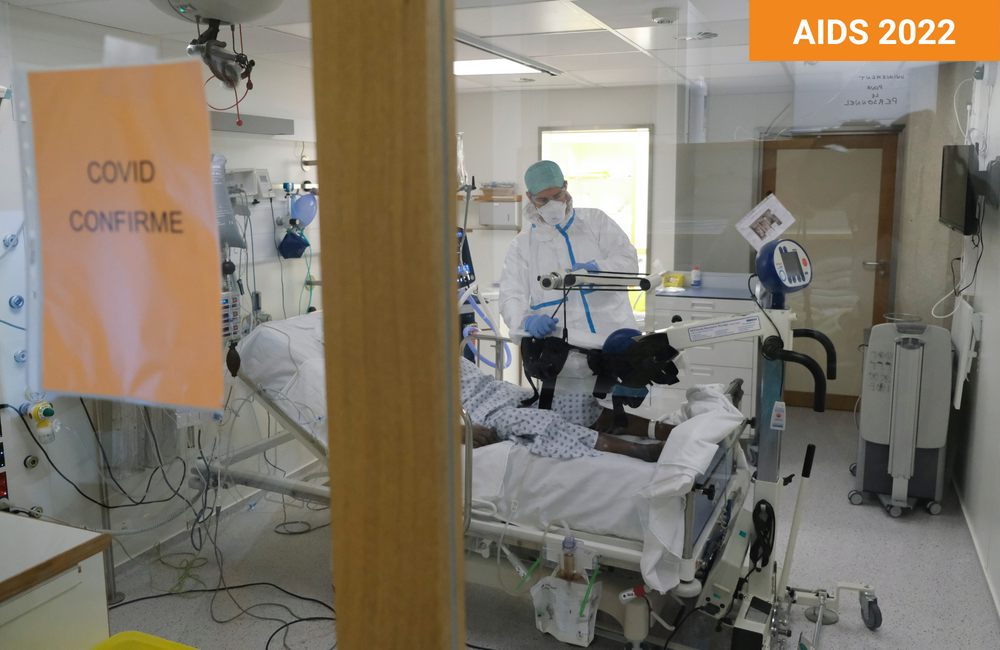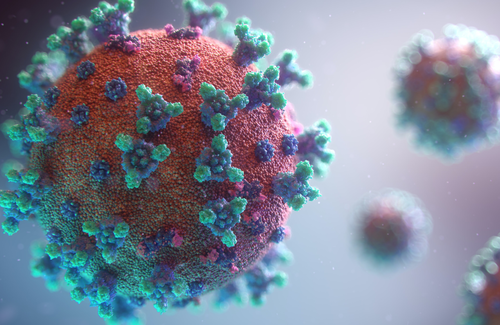
People with HIV remain at higher risk of dying after being admitted to hospital with COVID-19 and have not experienced the same decline in COVID-related mortality as HIV-negative people during the Omicron wave of the pandemic, a research team from the World Health Organization (WHO) reported this week at the 24th International AIDS Conference (AIDS 2022).
At last year’s IAS Conference on HIV Science, the same team presented results of a global analysis of data submitted to the WHO Global Clinical Platform on COVID-19, showing that people with HIV were more likely to be admitted to hospital with COVID-19 and 30% more likely to die after admission for COVID-19.
The updated study presented this week analysed further data submitted to the clinical platform from 50 countries on people hospitalised with COVID-19 from the beginning of the pandemic to May 2022. Data on HIV status of hospitalised patients was available for 42 countries, covering 362,841 people. Just over 8% (29,530) were living with HIV. Ninety-six per cent of the data on people with HIV came from Africa, predominantly from South Africa. This study was not able to collect data on vaccination status or previous COVID-19 illness, so it is not possible to say what effect they had on outcomes.
Several symptoms were more common in people with HIV compared to HIV-negative people. In order of frequency, fever (66%), shortness of breath (59%), fatigue (41%), headache (31%), chest pains (27%), loss of smell (25%) and muscle ache (19%) were more common in people with HIV than HIV-negative people. However, cough was somewhat less frequent in people with HIV (47%) than in HIV-negative people (53%).
Underlying health conditions were more common in people with HIV than HIV-negative people. Fifty-nine per cent of people with HIV who were hospitalised had at least one underlying health condition compared to 45% of HIV-negative people (p<0.001), most commonly hypertension (30%), obesity (29%), tuberculosis (27%) and diabetes (19%). With the exception of tuberculosis, which was much less common in HIV-negative people (2%), the prevalence of underlying conditions was similar in HIV-negative people. Seven per cent of people with HIV had at least three underlying health conditions.
In the updated analysis, people with HIV had a 51% increased risk of dying after admission to hospital with COVID-19, a slightly higher rate than reported previously.
Analysis by CD4 count (above or below 200) and viral load (above or below 1000) showed that having a CD4 count below 200 and a viral load above 1000 doubled the risk of dying after admission to hospital after adjusting for age, gender and co-morbidities (adjusted hazard ratio 1.96, 95% CI 1.81-2.12) when compared to HIV-negative people. People with HIV with CD4 counts below 200 and suppressed viral load (<1000 copies/ml) had a 62% higher risk (aHR 1.62, 95% CI 1.52-1.73) of dying.
A CD4 count above 200 and an unsuppressed viral load was associated with a 29% increase in the risk of dying while a CD4 count above 200 and a suppressed viral load was associated with a 12% increased risk of dying.
"The study findings emphasise the importance of promoting vaccination to people with HIV."
The WHO researchers also looked at changes in death rates over time. In 2020, during the Alpha and Beta variant waves of the pandemic, 24% of people with HIV and 21% of HIV-negative people died after hospitalisation with COVID-19. Death rates were similar in 2021 too, when Alpha, Beta and Delta variants predominated (24% and 22%, respectively). But in 2022, as the Omicron variant replaced previous variants, death rates diverged. Whereas the death rate after hospitalisation fell to 8% in the year to date in HIV-negative people, the death rate remains close to 20% in people with HIV (19.8%).
When they compared death rates between the Delta wave (August to October 2021) and the Omicron wave (November 2021 to May 2022) in South Africa, the researchers found that whereas people with HIV were 55% more likely to die during the Delta wave (aHR 1.55), they were more than twice as likely to die during the Omicron wave (aHR 2.47).
Dr Silvia Bertagnolio of WHO said that the continuing high death rate in people with HIV is also likely to reflect low vaccination coverage in the country contributing most of the data. By the end of 2021, 27% of South Africans had been vaccinated against COVID-19 and coverage is now estimated to have reached 32%. Bertagnolio said that vaccine coverage is still unacceptably low in sub-Saharan Africa, where 18% of the population have been vaccinated compared to a global average of 62%.
She said the study findings emphasise the importance of improving access to vaccination, promoting vaccination to people with HIV and making COVID-19 antiviral medication available for people with HIV to reduce the risk of severe outcomes.
She also stressed the importance of minimising exposure to COVID-19 among people with HIV, especially people with CD4 counts below 200 or co-morbidities, as well as ensuring uninterrupted antiretroviral treatment.
Lower CD4 count linked with infection
Preliminary results from the Ubuntu study of mRNA SARS-CoV-2 vaccination in South Africa, presented as a late breaker on the final day of AIDS 2022, reinforced the importance of minimising SARS-CoV-2 exposure in people with HIV.
Baseline screening results of the study, in which participants were tested for the virus before vaccination, showed that 31% of study participants screened during November and December 2021 at the beginning of the Omicron variant wave had positive SARS-CoV-2 PCR tests.
Between November 2021 and July 2022, 8% of people with HIV with no prior SARS-CoV-2 had asymptomatic SARS-CoV-2 at baseline. The risk of asymptomatic infection was higher in people without a prior history of SARS-CoV-2.
People with HIV with lower CD4 counts were at higher risk of being diagnosed with SARS-CoV-2 at baseline after adjusting for prior exposure, sex assigned at birth and temporal trend. Every tenfold reduction in CD4 count was associated with a doubling in the risk of a positive result. A person with a CD4 count of 50 had an approximately 50% probability of testing positive at baseline screening in December 2021 compared to a 25% probability in people with CD4 counts around 500.
Bertagnolio S et al. Are people living with HIV at higher risk of severe and fatal COVID-19? 24th International AIDs Conference, Montreal, abstract OAB0404, 2022.
View the abstract on the conference website.
Tapley A et al. High prevalence of asymptomatic Omicron carriage and correlation with CD4+ T cell count among adults with HIV enrolling in COVPN 3008 Ubuntu clinical trial in sub-Saharan Africa. 24th International AIDs Conference, Montreal, abstract OALBC0102, 2022.

